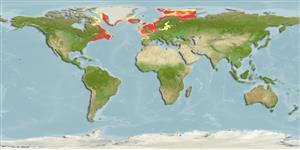Common names from other countries
Environment: milieu / climate zone / depth range / distribution range
Sinh thái học
Biển gần đáy; không di cư (Ref. 88171); Mức độ sâu 30 - 373 m (Ref. 58426), usually 40 - 100 m (Ref. 51666). Temperate; 8°C - 14°C (Ref. 89228); 80°N - 41°N, 71°W - 55°E
North Atlantic: Spitsbergen southward to Scandinavian coasts, North Sea, southern part of the Baltic, the Faroes, Iceland and south-eastern coasts of Greenland. Elsewhere, western coasts of Greenland; also, Labrador and Newfoundland to Massachusetts Bay (subspecies Lumpenus lumpretaeformis serpentinus Storer, Ref. 51666).
Length at first maturity / Bộ gần gũi / Khối lượng (Trọng lượng) / Age
Maturity: Lm 20.0 range ? - ? cm
Max length : 50.0 cm TL con đực/không giới tính; (Ref. 35388)
Elongated, eel-like fish with a pointed caudal fin. A single dorsal fin extends almost throughout the entire length of the body. The anal fin covers about two-thirds of the total length. Pale brown dorsally, becoming bluish on the sides, and greenish-yellow ventrally. There are numerous irregular brown patches on the body (Ref. 35388).
A benthic species (Ref. 58426), living in Y-shaped tubes in the mud in 50-200 m depth (Ref. 35388). The burrows are believed to be used for parental care of the eggs (Ref. 80819) . Feeds on small crustaceans, mollusks, brittle stars and worms (Ref. 5204). Matures at 3 years with about 20 cm length. Spawning takes place in December - January, 1,000 eggs are laid on the sea floor, in deep water (Ref. 35388). Isolated population in the Baltic Sea is probably a relict from the last ice age (Ref. 35388) that reached the Baltic Sea during the early saltwater stage of the sea (Ref. 82152; 82153).
Wheeler, A., 1992. A list of the common and scientific names of fishes of the British Isles. J. Fish Biol. 41(suppl.A):1-37. (Ref. 5204)
IUCN Red List Status (Ref. 130435)
CITES (Ref. 128078)
Not Evaluated
Threat to humans
Harmless
Human uses
Các nghề cá: không ích lợi (thú vị)
Thêm thông tin
Các tài liệu tham khảoNuôi trồng thủy sảnTổng quan nuôi trồng thủy sảnCác giốngDi truyềnElectrophoresesDi sảnCác bệnhChế biếnMass conversion
Các công cụ
Special reports
Download XML
Các nguồn internet
Estimates based on models
Preferred temperature (Ref.
115969): 0.4 - 8.5, mean 3.1 (based on 420 cells).
Phylogenetic diversity index (Ref.
82804): PD
50 = 0.6250 [Uniqueness, from 0.5 = low to 2.0 = high].
Bayesian length-weight: a=0.00129 (0.00052 - 0.00322), b=2.98 (2.76 - 3.20), in cm Total Length, based on LWR estimates for this (Sub)family-body shape (Ref.
93245).
Mức dinh dưỡng (Ref.
69278): 3.6 ±0.48 se; based on food items.
Thích nghi nhanh (Ref.
120179): Trung bình, thời gian nhân đôi của chủng quần tối thiểu là 1.4 - 4.4 năm (K=0.20; tmax=9;).
Fishing Vulnerability (Ref.
59153): Moderate to high vulnerability (50 of 100).
